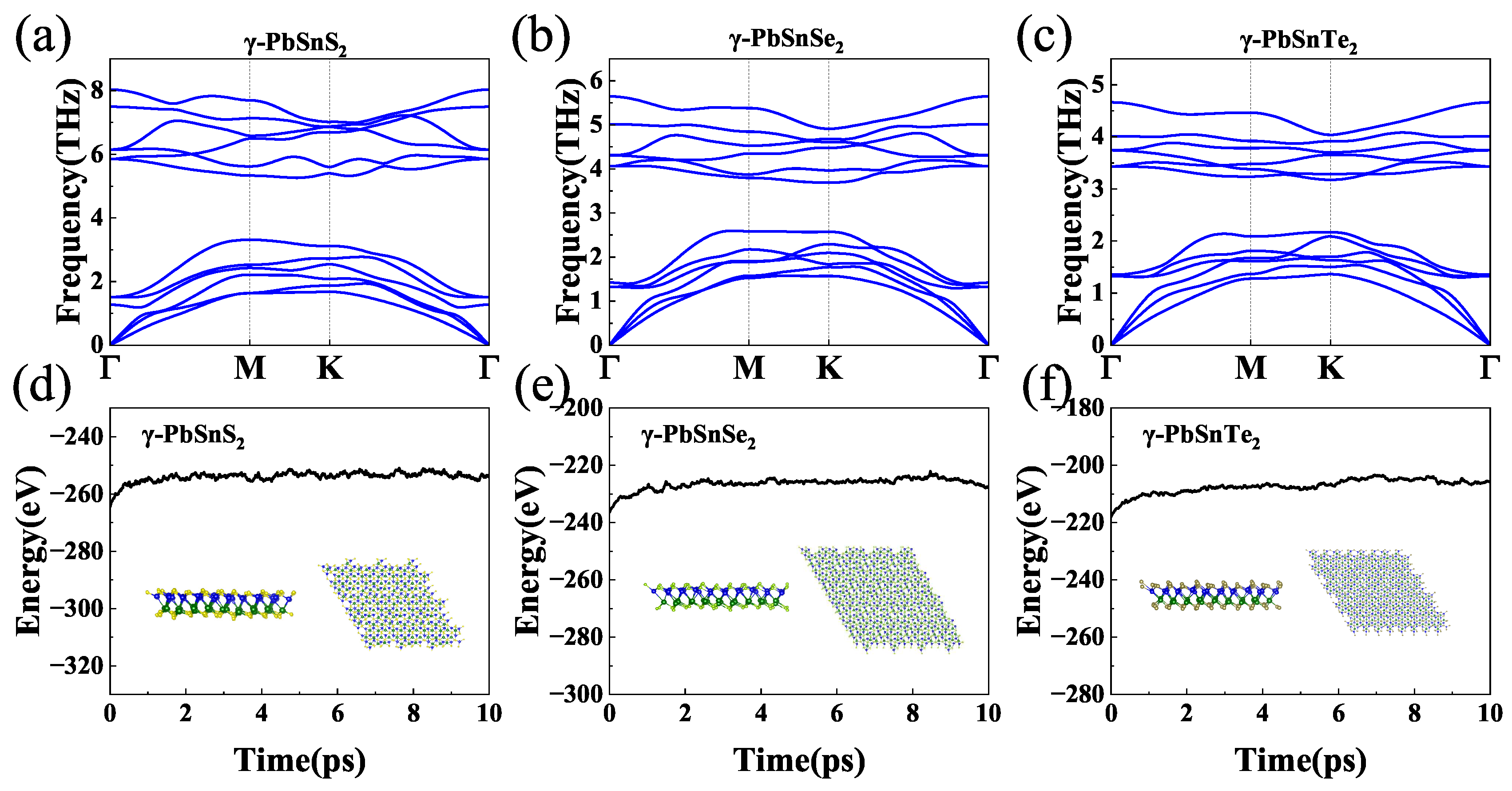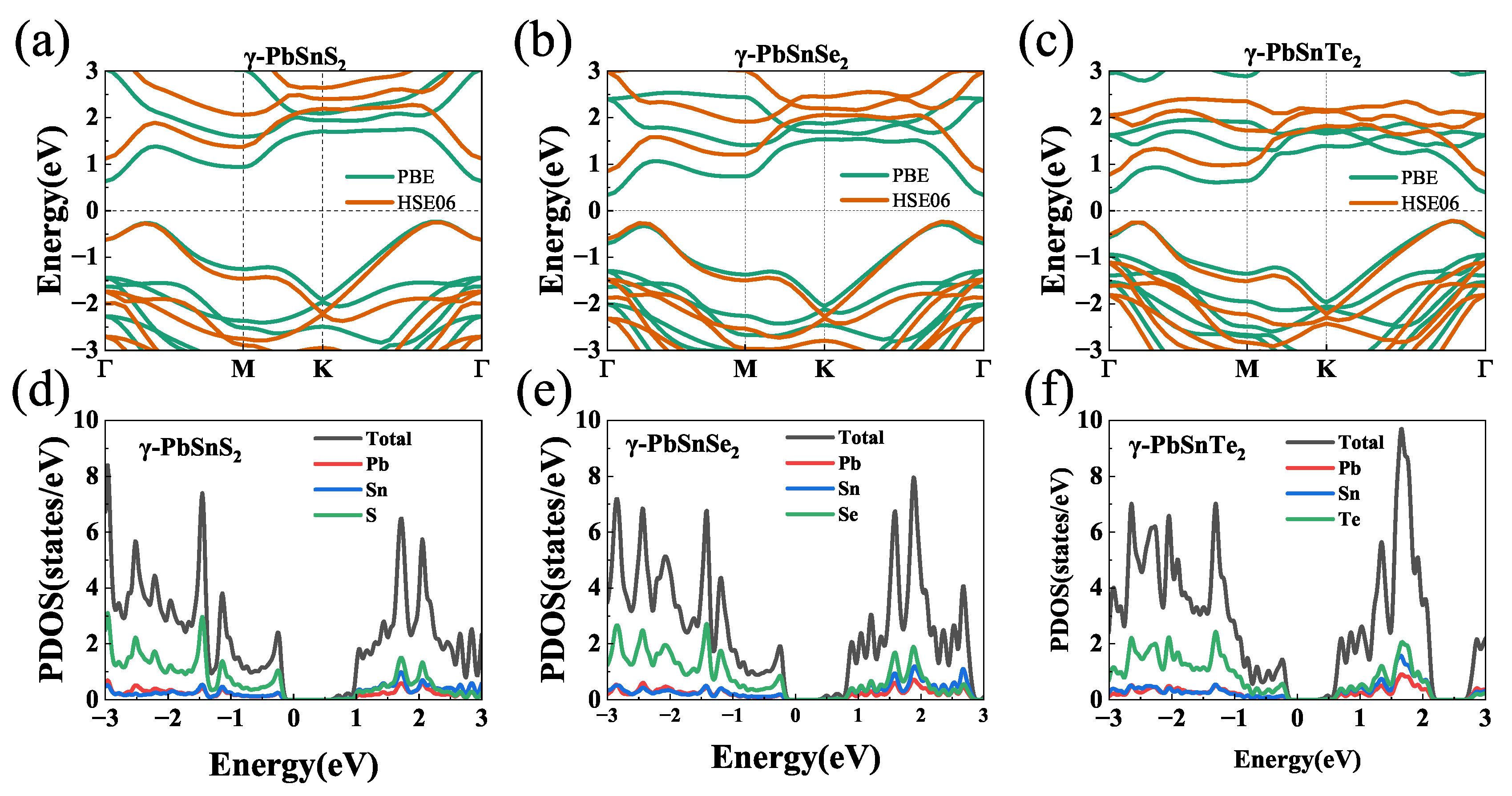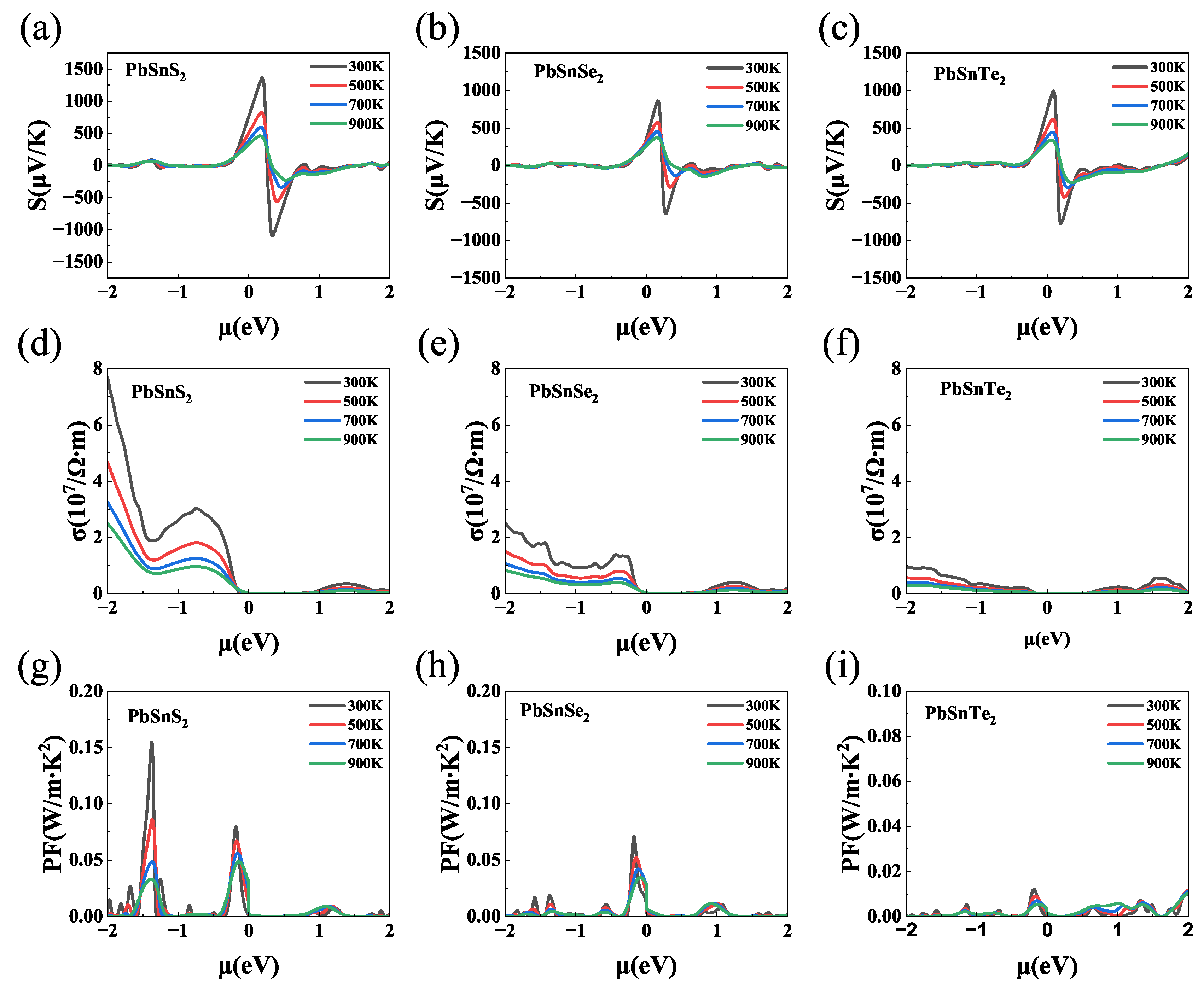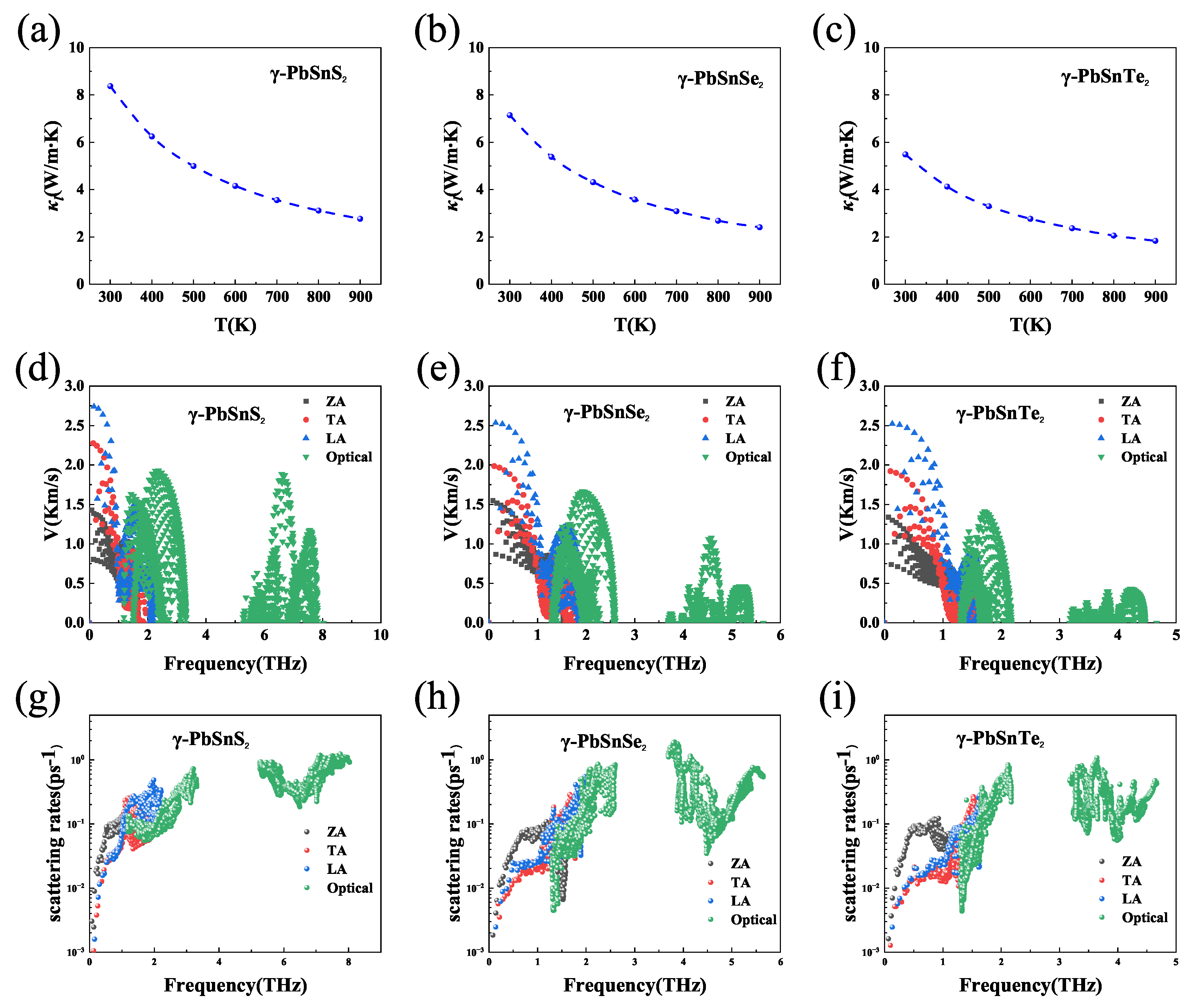Submitted:
17 April 2023
Posted:
17 April 2023
You are already at the latest version
Abstract
Keywords:
1. Introduction
2. Computational method
3. Results
3.1. Structure and stability
3.2. Electronic band structure
3.3. Carrier mobility and relaxation time
3.4. Thermoelectric properties
4. Conclusions
Author Contributions
Acknowledgments
Conflicts of Interest
References
- Chu, S.; Majumdar, A. Opportunities and challenges for a sustainable energy future. Nature 2012, 488, 294–303. [Google Scholar] [CrossRef] [PubMed]
- Yang, L.; Chen, Z.G.; Dargusch, M.S.; Zou, J. High Performance Thermoelectric Materials: Progress and Their Applications. Advanced Energy Materials 2018, 8, 1701797. [Google Scholar] [CrossRef]
- Huang, H.H.; Fan, X.; Singh, D.J.; Zheng, W.T. Thermoelectric properties of monolayer GeAsSe and SnSbTe. Journal of Materials Chemistry C 2020, 8, 9763–9774. [Google Scholar] [CrossRef]
- Wu, D.; Cao, X.H.; Chen, S.Z.; Tang, L.M.; Feng, Y.X.; Chen, K.Q.; Zhou, W.X. Pure spin current generated in thermally driven molecular magnetic junctions: a promising mechanism for thermoelectric conversion. Journal of Materials Chemistry A 2019, 7, 19037–19044. [Google Scholar] [CrossRef]
- Jonson, M.; Mahan, G.D. Mott’s formula for the thermopower and the Wiedemann-Franz law. Physical Review B 1980, 21, 4223–4229. [Google Scholar] [CrossRef]
- Ding, Z.K.; Zeng, Y.J.; Pan, H.; Luo, N.; Zeng, J.; Tang, L.M.; Chen, K.Q. Edge states of topological acoustic phonons in graphene zigzag nanoribbons. Physical Review B 2022, 106, L121401. [Google Scholar] [CrossRef]
- Pan, H.; Ding, Z.K.; Zeng, B.W.; Luo, N.N.; Zeng, J.; Tang, L.M.; Chen, K.Q. Ab initio Boltzmann approach to coupled magnon-phonon thermal transport in ferromagnetic crystals. Physical Review B 2023, 107, 104303. [Google Scholar] [CrossRef]
- Pan, H.; Ding, Z.K.; Zeng, Y.J.; Li, Q.Q.; Tang, L.M.; Chen, K.Q. Tuning quantum heat transport in magnetic nanostructures by spin-phonon interaction. Europhysics Letters 2022, 138, 36001. [Google Scholar] [CrossRef]
- Pan, H.; Tang, L.M.; Chen, K.Q. Quantum mechanical modeling of magnon-phonon scattering heat transport across three-dimensional ferromagnetic/nonmagnetic interfaces. Physical Review B 2022, 105, 064401. [Google Scholar] [CrossRef]
- Zeng, B.; Ding, Z.K.; Pan, H.; Luo, N.; Zeng, J.; Tang, L.M.; Chen, K.Q. Strong strain-dependent phonon hydrodynamic window in bilayer graphene. Applied Physics Letters 2022, 121, 252202. [Google Scholar] [CrossRef]
- Zeng, Y.J.; Ding, Z.K.; Pan, H.; Feng, Y.X.; Chen, K.Q. Nonequilibrium Green’s function method for phonon heat transport in quantum system. Journal of Physics: Condensed Matter 2022, 34, 223001. [Google Scholar] [CrossRef]
- Zeng, Y.J.; Wu, D.; Cao, X.H.; Zhou, W.X.; Tang, L.M.; Chen, K.Q. Nanoscale Organic Thermoelectric Materials: Measurement, Theoretical Models, and Optimization Strategies. Advanced Functional Materials 2020, 30, 1903873. [Google Scholar] [CrossRef]
- Guo, S.D. Biaxial strain tuned thermoelectric properties in monolayer PtSe2. Journal of Materials Chemistry C 2016, 4, 9366–9374. [Google Scholar] [CrossRef]
- Lin, C.M.; Chen, W.C.; Chen, C.C. First-principles study of strain effect on the thermoelectric properties of LaP and LaAs. Physical Chemistry Chemical Physics 2021, 23, 18189–18196. [Google Scholar] [CrossRef] [PubMed]
- Miao, T.; Yu, D.; Xing, L.; Li, D.; Jiao, L.; Ma, W.; Zhang, X. Current Rectification in a Structure: ReSe2/Au Contacts on Both Sides of ReSe2. Nanoscale Research Letters 2019, 14, 1. [Google Scholar] [CrossRef] [PubMed]
- Wu, C.W.; Ren, X.; Xie, G.; Zhou, W.X.; Zhang, G.; Chen, K.Q. Enhanced High-Temperature Thermoelectric Performance by Strain Engineering in BiOCl. Physical Review Applied 2022, 18, 014053. [Google Scholar] [CrossRef]
- Wu, Y.; Chen, Z.; Nan, P.; Xiong, F.; Lin, S.; Zhang, X.; Chen, Y.; Chen, L.; Ge, B.; Pei, Y. Lattice Strain Advances Thermoelectrics. Joule 2019, 3, 1276–1288. [Google Scholar] [CrossRef]
- Zhou, W.X.; Wu, D.; Xie, G.; Chen, K.Q.; Zhang, G. α-Ag2S: A Ductile Thermoelectric Material with High ZT. ACS Omega 2020, 5, 5796–5804. [Google Scholar] [CrossRef]
- Gu, B.C.; Li, Z.; Liu, J.D.; Zhang, H.J.; Ye, B.J. Effect of vacancies on thermoelectric properties of β-CuAgSe studied by positron annihilation. Applied Physics Letters 2019, 115, 192106. [Google Scholar] [CrossRef]
- Han, D.; Yang, X.; Du, M.; Xin, G.; Zhang, J.; Wang, X.; Cheng, L. Improved thermoelectric properties of WS2–WSe2 phononic crystals: insights from first-principles calculations. Nanoscale 2021, 13, 7176–7192. [Google Scholar] [CrossRef]
- Xie, Z.X.; Chen, X.K.; Yu, X.; Deng, Y.X.; Zhang, Y.; Zhou, W.X.; Jia, P.Z. Intrinsic thermoelectric properties in biphenylene nanoribbons and effect of lattice defects. Computational Materials Science 2023, 220, 112041. [Google Scholar] [CrossRef]
- Cao, X.H.; Wu, D.; Feng, Y.X.; Zhou, W.X.; Tang, L.M.; Chen, K.Q. Effect of electrophilic substitution and destructive quantum interference on the thermoelectric performance in molecular devices. Journal of Physics: Condensed Matter 2019, 31, 345303. [Google Scholar] [CrossRef] [PubMed]
- Deng, Y.X.; Chen, S.Z.; Hong, J.; Jia, P.Z.; Zhang, Y.; Yu, X.; Chen, K.Q. Perfect spin-filtering effect in molecular junctions based on half-metallic penta-hexa-graphene nanoribbons. Journal of Physics: Condensed Matter 2022, 34, 285302. [Google Scholar] [CrossRef] [PubMed]
- Zeng, Y.J.; Wu, D.; Cao, X.H.; Feng, Y.X.; Tang, L.M.; Chen, K.Q. Significantly enhanced thermoelectric performance of molecular junctions by the twist angle dependent phonon interference effect. Journal of Materials Chemistry A 2020, 8, 11884–11891. [Google Scholar] [CrossRef]
- Gibson, Q.D.; Zhao, T.; Daniels, L.M.; Walker, H.C.; Daou, R.; Hebert, S.; Zanella, M.; Dyer, M.S.; Claridge, J.B.; Slater, B.; et al. Low thermal conductivity in a modular inorganic material with bonding anisotropy and mismatch. Science 2021, 373, 1017–1022. [Google Scholar] [CrossRef] [PubMed]
- Wang, J.; Cao, X.H.; Zeng, Y.J.; Luo, N.N.; Tang, L.M.; Chen, K.Q. Excellent thermoelectric properties of monolayer MoS2-MoSe2 aperiodic superlattices. Applied Surface Science 2023, 612, 155914. [Google Scholar] [CrossRef]
- Xie, Z.X.; Zhang, Y.; Yu, X.; Li, K.M.; Chen, Q. Ballistic thermal conductance by phonons through superlattice quantum-waveguides. Journal of Applied Physics 2014, 115, 104309. [Google Scholar] [CrossRef]
- Jia, P.Z.; Xie, J.P.; Chen, X.K.; Zhang, Y.; Yu, X.; Zeng, Y.J.; Xie, Z.X.; Deng, Y.X.; Zhou, W.X. Recent progress of two-dimensional heterostructures for thermoelectric applications. Journal of Physics: Condensed Matter 2023, 35, 073001. [Google Scholar] [CrossRef]
- Jia, P.Z.; Zeng, Y.J.; Wu, D.; Pan, H.; Cao, X.H.; Zhou, W.X.; Xie, Z.X.; Zhang, J.X.; Chen, K.Q. Excellent thermoelectric performance induced by interface effect in MoS2/MoSe2 van der Waals heterostructure. Journal of Physics: Condensed Matter 2020, 32, 055302. [Google Scholar] [CrossRef]
- Hicks, L.D.; Dresselhaus, M.S. Thermoelectric figure of merit of a one-dimensional conductor. Physical Review B 1993, 47, 16631–16634. [Google Scholar] [CrossRef]
- Shafique, A.; Shin, Y.H. Thermoelectric and phonon transport properties of two-dimensional IV–VI compounds. Scientific Reports 2017, 7, 506. [Google Scholar] [CrossRef]
- Gupta, R.; Kakkar, S.; Dongre, B.; Carrete, J.; Bera, C. Enhancement in the Thermoelectric Performance of SnS Monolayer by Strain Engineering. ACS Applied Energy Materials 2023, 6, 3944–3952. [Google Scholar] [CrossRef]
- Lu, A.Y.; Zhu, H.; Xiao, J.; Chuu, C.P.; Han, Y.; Chiu, M.H.; Cheng, C.C.; Yang, C.W.; Wei, K.H.; Yang, Y.; et al. Janus monolayers of transition metal dichalcogenides. Nature Nanotechnology 2017, 12, 744–749. [Google Scholar] [CrossRef] [PubMed]
- Sa, B.; Sun, Z.; Wu, B. The development of two dimensional group IV chalcogenides, blocks for van der Waals heterostructures. Nanoscale 2016, 8, 1169–1178. [Google Scholar] [CrossRef] [PubMed]
- Dong, B.; Wang, Z.; Hung, N.T.; Oganov, A.R.; Yang, T.; Saito, R.; Zhang, Z. New two-dimensional phase of tin chalcogenides: Candidates for high-performance thermoelectric materials. Physical Review Materials 2019, 3, 013405. [Google Scholar] [CrossRef]
- Jia, P.Z.; Xie, Z.X.; Deng, Y.X.; Zhang, Y.; Tang, L.M.; Zhou, W.X.; Chen, K.Q. High thermoelectric performance induced by strong anharmonic effects in monolayer (PbX)2 (X = S, Se, Te). Applied Physics Letters 2022, 121, 043901. [Google Scholar] [CrossRef]
- Kresse, G.; Furthmüller, J. Efficient iterative schemes for ab initio total-energy calculations using a plane-wave basis set. Physical Review B 1996, 54, 11169–11186. [Google Scholar] [CrossRef] [PubMed]
- Stratmann, R.E.; Scuseria, G.E.; Frisch, M.J. An efficient implementation of time-dependent density-functional theory for the calculation of excitation energies of large molecules. The Journal of Chemical Physics 1998, 109, 8218–8224. [Google Scholar] [CrossRef]
- Perdew, J.P.; Burke, K.; Ernzerhof, M. Generalized Gradient Approximation Made Simple. Physical Review Letters 1996, 77, 3865–3868. [Google Scholar] [CrossRef]
- Kresse, G.; Joubert, D. From ultrasoft pseudopotentials to the projector augmented-wave method. Physical Review B 1999, 59, 1758–1775. [Google Scholar] [CrossRef]
- Monkhorst, H.J.; Pack, J.D. Special points for Brillouin-zone integrations. Physical Review B 1976, 13, 5188–5192. [Google Scholar] [CrossRef]
- Grimme, S.; Ehrlich, S.; Goerigk, L. Effect of the damping function in dispersion corrected density functional theory. Journal of Computational Chemistry 2011, 32, 1456–1465. [Google Scholar] [CrossRef] [PubMed]
- Madsen, G.K.H.; Singh, D.J. BoltzTraP. A code for calculating band-structure dependent quantities. Computer Physics Communications 2006, 175, 67–71. [Google Scholar] [CrossRef]
- Li, W.; Carrete, J.; A. Katcho, N.; Mingo, N. ShengBTE: A solver of the Boltzmann transport equation for phonons. Computer Physics Communications 2014, 185, 1747–1758. [Google Scholar] [CrossRef]
- Bruzzone, S.; Fiori, G. Ab-initio simulations of deformation potentials and electron mobility in chemically modified graphene and two-dimensional hexagonal boron-nitride. Applied Physics Letters 2011, 99, 222108. [Google Scholar] [CrossRef]
- Fiori, G.; Iannaccone, G. Multiscale Modeling for Graphene-Based Nanoscale Transistors. Proceedings of the IEEE 2013, 101, 1653–1669. [Google Scholar] [CrossRef]
- Lang, H.; Zhang, S.; Liu, Z. Mobility anisotropy of two-dimensional semiconductors. Physical Review B 2016, 94, 235306. [Google Scholar] [CrossRef]
- Rawat, A.; Jena, N.; Dimple. ; De Sarkar, A. A comprehensive study on carrier mobility and artificial photosynthetic properties in group VI B transition metal dichalcogenide monolayers. Journal of Materials Chemistry A 2018, 6, 8693–8704. [Google Scholar] [CrossRef]
- Shafique, A.; Samad, A.; Shin, Y.H. Ultra low lattice thermal conductivity and high carrier mobility of monolayer SnS2 and SnSe2: a first principles study. Physical Chemistry Chemical Physics 2017, 19, 20677–20683. [Google Scholar] [CrossRef]
- Hung, N.T.; Hasdeo, E.H.; Nugraha, A.R.; Dresselhaus, M.S.; Saito, R. Quantum Effects in the Thermoelectric Power Factor of Low-Dimensional Semiconductors. Physical Review Letters 2016, 117, 036602. [Google Scholar] [CrossRef]
- Hung, N.T.; Nugraha, A.R.T.; Yang, T.; Saito, R. Confinement Effect in Thermoelectric Properties of Two–Dimensional Materials. MRS Advances 2020, 5, 469–479. [Google Scholar] [CrossRef]
- Li, Y.; Wu, M.N.; Ding, T.; Ma, K.; Liu, F.S.; Ao, W.Q.; Li, J.Q. Promising thermoelectric properties and anisotropic electrical and thermal transport of monolayer SnTe 2019. 114 083901. [CrossRef]
- Kumar, S.; Schwingenschlögl, U. Thermoelectric Response of Bulk and Monolayer MoSe2 and WSe2. Chemistry of Materials 2015, 27, 1278–1284. [Google Scholar] [CrossRef]
- Patel, A.; Singh, D.; Sonvane, Y.; Thakor, P.B.; Ahuja, R. High Thermoelectric Performance in Two-Dimensional Janus Monolayer Material WS-X (X = Se and Te). ACS Applied Materials & Interfaces 2020, 12, 46212–46219. [Google Scholar] [CrossRef]






| Material | a (Å) | d (Å) | d (Å) | d (Å) | h (Å) | = | |
|---|---|---|---|---|---|---|---|
| PbSnS | 3.96 | 2.64 | 2.68 | 3.58 | 5.49 | 90° | 120° |
| PbSnSe | 4.11 | 2.77 | 2.81 | 3.51 | 5.52 | 90° | 120° |
| PbSnTe | 4.37 | 2.97 | 3.01 | 3.46 | 5.59 | 90° | 120° |
| Material | Structure | Gap-type | E (PBE) | E (HSE06) |
|---|---|---|---|---|
| PbSnS | hexagonal (2D) | Indirect | 0.86 eV | 1.37 eV |
| PbSnSe | hexagonal (2D) | Indirect | 0.63 eV | 1.08 eV |
| PbSnTe | hexagonal (2D) | Indirect | 0.61 eV | 0.98 eV |
| Material | Carrier | (N/m) | (eV) | (×10cmVs) | (ps) | |
|---|---|---|---|---|---|---|
| PbSnS | e | 39.5 | 0.22 | 4.92 | 0.476 | 0.059 |
| h | 0.50 | 1.02 | 4.04 | 1.14 | ||
| PbSnSe | e | 42.75 | 0.18 | 5.52 | 0.654 | 0.067 |
| h | 0.357 | 2.66 | 1.421 | 0.288 | ||
| PbSnTe | e | 43.55 | 0.23 | 6.52 | 0.256 | 0.033 |
| h | 0.596 | 4.14 | 0.245 | 0.083 |
Disclaimer/Publisher’s Note: The statements, opinions and data contained in all publications are solely those of the individual author(s) and contributor(s) and not of MDPI and/or the editor(s). MDPI and/or the editor(s) disclaim responsibility for any injury to people or property resulting from any ideas, methods, instructions or products referred to in the content. |
© 2023 by the authors. Licensee MDPI, Basel, Switzerland. This article is an open access article distributed under the terms and conditions of the Creative Commons Attribution (CC BY) license (http://creativecommons.org/licenses/by/4.0/).





